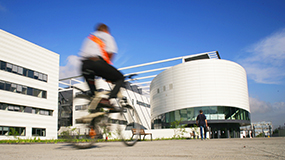 Recherche
Recherche
Laboratoires.Ecoles, Collège et Formation doctorales
Stratégie. Séminaires, colloques. Sciences et société
Réseaux et pôles d'excellence. Investissements d'avenir (Labex)
The LIG Keynotes
Jim Roberts currently has a part-time position with Telecom ParisTech after spells as a senior researcher with IRT-SystemX (2013-2016) and Inria (2009-2013). He was previously with the research labs of France Telecom/Orange for more than 30 years and with British Telecom for 5 years before that. He has a BSc in mathematics from the University of Surrey, UK and a PhD from the University of Paris. His research has been focused on the performance evaluation and design of traffic controls for communication networks, starting with the telephone network and evolving through technology shifts to the Internet and future Internet. He has published extensively in journals and conferences and been a member of several journal editorial boards and many conference programme committees in the networking field. He was TPC co-chair for several conferences including Infocom 2003. He was made a fellow of Orange Labs and SEE and received a lifetime achievement award from the International Teletraffic Congress in 2010.
Some 96% of Internet traffic is currently generated by the transfer of digitized content, directly from content providers (CPs) like Netflix and Google, or via content delivery networks (CDNs) like Akamai and Limelite. In such a content-centric network there is clearly scope for significant economies in the cost of infrastructure by trading off memory for bandwidth. By retrieving popular content items from local storage, requirements for upstream bandwidth are greatly reduced. These economies are imperfectly realized in the current network where there is a mismatch between the objectives of network operators on one hand, and major CPs and CDNs on the other. The latter tend to jealously protect their profitable business models, notably by encrypting content delivery and thus preventing operators from transparently caching popular items at advantageous sites. They also have little incentive to cooperate in optimizing infrastructure costs through proactive placements, as long as their customers experience adequate quality. The talk will discuss how the Internet is likely to change to more effectively deal with its content-centric demand. Our analysis is based on mathematical models developed to determine cache hit rates accounting for observed characteristics of content popularity. These models enable a quantification of the memory for bandwidth tradeoff and an evaluation of alternative network structures. Our conclusion is that the future Internet will deliver the vast majority of content from datacenter-equipped central offices at the edge of the core network, or from caches located even closer to users in the access network. Most content delivery will still be controlled by major CPs and CDNs and we discuss how the network infrastructure owner will be able to persuade them to realize optimal placements through an appropriate pricing scheme.
Informations
- Gricad Vidéos
- 1 janvier 2021 00:00
- Conférences
- Français

